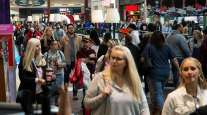Consumer Spending Rises Little in September

Household spending rose less than forecast in September, showing the biggest part of the U.S. economy ended a strong quarter on a weak note.
Purchases increased 0.1%, the smallest gain since January, after rising 0.4% in August, Commerce Department figures showed Oct. 30. The median forecast of 75 economists in a Bloomberg News survey called for a 0.2% advance. The first drop in prices since January helped take some of the sting out of a smaller-than-projected advance in incomes.
Americans pulled back amid turmoil in financial markets caused by signs that global growth was weakening. It will take a pickup in wage growth to ensure American households remain the linchpin of economic growth heading into the holiday shopping season.
“There was a definite loss of momentum as we were coming out of the third quarter, but don’t worry too seriously about that,” said Scott Brown, chief economist at Raymond James Financial Inc. in St. Petersburg, Florida, who correctly projected the spending advance. “The job growth is positive, but we’ll need to see better wage growth down the line.”
Projections for consumer spending in the Bloomberg survey ranged from little change to a 0.4% gain.
Wages were unchanged in September, the weakest reading in six months, after a 0.5% advance the prior month. That meant total incomes rose just 0.1% after a 0.4% increase in August. The Bloomberg survey median called for incomes to rise 0.2%.
A separate report Oct. 30 from the Labor Department showed wages and salaries rose 0.6% in the third quarter and were up 2.1% from the same time last year. The year-to-year reading matched the increase in the prior quarter.
A lack of inflation is helping augment weak income gains. The Commerce Department’s report showed the price index tied to consumer purchases decreased 0.1% in September from the prior month, the first drop since January. It rose 0.2% from the same time in 2014, compared with a 0.3% gain in the year ended in August. This inflation gauge is preferred by Federal Reserve policymakers and hasn’t met their 2% goal since April 2012.
Stripping out the volatile food and energy categories, the price measure climbed 0.1% from August and rose 1.3% in the 12 months ended in September.
Fed officials said at the close of their two-day meeting in Washington on Oct. 28 that they will consider tightening policy at their next meeting, in December, based on “realized and expected” progress in reaching their employment and inflation goals.
The central bankers removed a line from September’s meeting statement about global economic and financial developments restraining economic activity while noting the economy continues to expand at a “moderate” pace.
The data also showed that after adjusting for inflation, in order to generate the figures used to calculate GDP, purchases increased 0.2% last month after a 0.4% advance in August.
Steady gains in consumer purchases will be needed to keep U.S. growth churning. The economy expanded at a 1.5% pace in the third quarter as businesses trimmed bloated inventories, Commerce Department data showed Oct. 29.
Consumer spending climbed 3.2% last quarter, exceeding the average of the prior five years, according to the Oct. 29 report. The report showed the breakdown for the quarter.
Stable job growth in 2015 and cheaper prices at the pump have helped cushion Americans’ pocketbooks, supporting household spending. While payrolls advanced at a slower pace than forecast in August and September, employment this year has increased by 198,000 a month on average, beating seven of the 10 years through 2014.
Gasoline costs have been receding for the past two months. The average price of a gallon of regular gasoline fell to $2.19 as of Oct. 28, the lowest since February, according to auto group AAA. That compares with a daily average in 2014 of $3.34 per gallon.
Disposable income, or the money remaining after taxes, climbed 0.2% in September from the prior month after adjusting for inflation. It was up 3.4% over the past year, the most since February. The saving rate increased to 4.8% from 4.7% in August.




